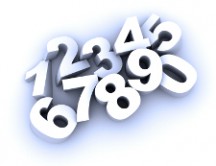Your Body by The Numbers – A Weight Loss Cheat Sheet

There are so many numbers being thrown at you when it comes to losing weight, getting fit and eating healthy, it’s no wonder people just focus on the number on the scale.
But that number on the scale doesn’t tell you everything. Focusing only on a weight loss goal can sometimes be unmotivating (if you don’t see the scale drop fast enough). It can also be misleading (if you’re gaining muscle, for example).
And let’s face it, while we’d all love to look like fitness models, it’s just not realistic to set that as a goal. Not even fitness models look like fitness models all the time.
I’m not saying it’s impossible. It’s just that the goal is always to be healthy.
Here’s a cheat sheet you can use on a regular basis to make sure you’re working your way towards healthy fat loss and fitness goals.
Body Measurements – Where Do You Stand?
According to the American Council on Exercise (ACE), the “average” body fat percentage for a female.Once you get your body down to “average”, you can then decide if you want to go for the “fitness” level of 21% to 24%.
Average body fat percentage for a male. Fitness level for a male is 14% to 17%.
Waist to hip ratio for a female. This is a way to determine your body fat distribution. You’ll want to aim for less than a 0.86 ratio.
Waist to hip ratio for a male. 0.95 brings you to the top of the “average” norm. Aim for lower
Waist circumference for a female inches. Measure your waist at the narrowest part of the torso. Is it greater than 35 inches? If so, it’s a strong indication of carrying fat in your abdominal area. Abdominal fat — as opposed to say, fat on your thighs — puts you in a higher risk level for things like heart disease and diabetes.
Waist circumference for a male in inches.
“Normal” body mass index (BMI). There is some controversy with BMI. On its own, a high BMI level can be misleading because it doesn’t take muscle mass into account. But if other indicators, such as your body fat percentage, waist to hip ratio or waist circumference are too high, chances are your BMI is on target. Aim for
Exercise Minimums – Do You Exercise Enough?
Here are the general guidelines for the minimum amount of exercise you need to stay healthy. Are you anywhere near the minimums? If not, don’t just jump in and try to reach the minimum. You’ll end up hurting yourself. Talk to your doctor if you haven’t exercised in a while, and then work your way up to the minimum.
Once you have the minimum under your belt — your shrinking belt, that is! — you can do more to increase the frequency, duration and intensity.
Minutes of moderate cardio exercise to aim for per week. Spread out over seven days, that’s 21 minutes a day. Or you could exercise 30 minutes five times a week. You can even break up one 30 minute session into 3 ten minute sessions in a day.
Sessions per week you should be doing strength training. Train all major muscle groups in a variety of ways, aiming for two to four sets and eight to ten reps per set.
Minimum sessions per week for flexibility and stretching exercises.
Seconds to hold a stretch.
The amount of time you should spend sitting. Okay, zero seems unrealistic and we all need to sit at some point. But evidence is growing that sitting is not good for your health. Even if you exercise. Get moving. Get a standing desk. Exercise while watching TV.
Eating Healthy – Number to Keep an Eye On
Minimum amount of calories for a woman. You shouldn’t be going lower than this without talking to your doctor. If you exercise, you should be eating more than the minimum
Minimum amount of calories for a man.
Calculate your Total Daily Needs
If you need to lose weight, calculate your calorie deficit.
According to ACE guidelines:
Percentage of calories from carbs to eat in a day. If you do a lot of cardio exercise, aim for the higher end of the range.
Percentage of calories from fat to eat in a day. Stay away from saturated and trans fats.
Percentage of calories from protein to eat in a day. Get your protein from lean meat and other healthy sources of protein.
Maximum amount of sodium in mg to consume in one day, as recommended by the American Heart Association
Amount of fiber (in grams) to consume per day for females 50 or younger.
Amount of fiber (in grams) to consume per day for males 50 or younger.
One thing I like about looking at numbers is that you can drill down to more specific goals to track your progress and to motivate yourself into sticking to your weight loss plan.
How do you stack up against the numbers? Does realizing you’re in a high risk zone motivate you more?
Must Read
How Many Calories Do I Burn in a Day?
